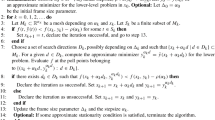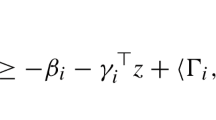Abstract
In this paper, we establish a connection between the local maximizers (global maximizers) of a Motzkin-Straus quadratic program and a specific type of regular multipartite cliques. Our work extends a remarkable connection between the maximum cliques and the global maximizers of the Motzkin-Straus quadratic program. This connection and its extensions can be successfully employed in optimization to provide heuristics for the maximal cliques in graphs. We provide two counterexamples to the results from previous work about the global and local maximizers of the Motzkin-Straus quadratic program. We then amend the previous theorems by introducing a new structure. We also answer two questions raised by Pelillo and Jagota about the maxima of the Motzkin-Straus quadratic program.


Similar content being viewed by others
Notes
While the Lagrangian is typically used as a function, in extremal graph theory, the Lagrangian for a graph is the maximum value of a polynomial function over the standard simplex. This definition was first used by Motzkin and Straus in the classical paper: Maxima for graphs and a new proof of a theorem of Turán.
In the more standard terminology (and that adopted here), the (n, k)-Turán graph, denoted T(n, k), is the extremal graph on n graph vertices that contains no \((k+1)\)-clique for \(1 \le k \le n\) (Diestel 1997 [6], p. 149; Bollobás 1998, p. 108 [2], and Gross and Yellen 2006, p. 476 [8]). Unfortunately, some authors, including Skiena (1990, pp. 143-144 [24]), Aigner (1995) [1], and Pemmaraju and Skiena (2003, pp. 247-248 [20]), use the convention that the (n, k)-Turán graph contains no k-clique (instead of \((k+1)\)-clique), meaning that the T(n, k)-Turán graph of these authors is the \((n,k-1)\)-Turán graph as defined above.
References
Aigner, M.: Turán’s graph theorem. Amer. Math. Monthly 102, 808–816 (1995)
Bollobás, B.: Modern graph theory. Springer-Verlag, New York (1998)
Bomze, I.M.: Evolution towards the maximum clique. J. Global Optimiz. 10(2), 143–164 (1997)
Budinich, M.: Exact bounds on the order of the maximum clique of a graph. Discret. Appl. Math. 127, 535–543 (2003)
Busygin, S.: A new trust region technique for the maximum weight clique problem. Discret. Appl. Math. 304(4), 2080–2096 (2006)
Diestel, R.: Graph theory, 3rd edn. Springer-Verlag, New York (1997)
Gibbons, L.E., Hearn, D.W., Pardalos, P.M., Ramana, M.V.: Continuous characterizations of the maximum clique problem. Math. Oper. Res. 22, 754–768 (1997)
Gross, J.T., Yellen, J.: Graph theory and its applications, 2nd edn., pp. 476–477. CRC Press, Boca Raton (2006)
Hungerford, J.T., Rinaldi, F.: A general regularized continuous formulation for the maximum clique problem. Math. Oper. Res. 44(4), 1161–1173 (2017)
Liu, H., Latecki, J., Yan, S.: Robust clustering as ensembles of affinity relations. In: Advances in Neural Information Processing Systems, pp. 1414-1422 (2010)
Luenberger, D., Ye, Y.: Linear and nonlinear programming, 3rd edn. Springer Science Business Media, LLC, Reading (2008)
Motzkin, T.S., Straus, E.G.: Maxima for graphs and a new proof of a theorem of Turán. Canad. J. Math. 17, 533–540 (1965)
Pavan, M., Pelillo, M.: Generalizing the Motzkin-Straus theorem to edge-weighted graphs, with applications to image segmentation. Lect. Notes Comput. Sci. 2683, 485–500 (2003)
Pardalos, P.M., Phillips, A.T.: A global optimization approach for solving the maximum clique problem. Int. J. Comput. Math. 33, 209–216 (1990)
Pavan, M., Pelillo, M.: Dominant sets and pairwise clustering. IEEE Trans. Pattern Anal. Mach. Intell. 29, 167–172 (2007)
Pelillo, M.: Replicator equations, maximal cliques, and graph isomorphism. Neural Comput. 11(8), 1933–1955 (1999)
Pelillo, M.: Matching free trees, maximal cliques, and monotone game dynamics. Pattern Anal. Mach. Intell. 24(11), 1535–1541 (2002)
Pelillo, M., Jagota, A.: Feasible and infeasible maxima in a quadratic program for maximum clique. Artif. Neural Networks 4, 411–420 (1995)
Pelillo, M., Siddiqi, K., Zucker, S.W.: Matching hierarchical structures using association graphs. IEEE Trans. Pattern Anal. Mach. Intell. 21(11), 1105–1120 (1999)
Pemmaraju, S., Skiena, S.: Computational discrete mathematics: combinatorics and graph theory in mathematica. Cambridge University Press, Cambridge (2003)
Reinhard, D.: Graph theory. Springer-Verlag, New York (2000)
Rota Buló, S.: A continuous characterization of maximal cliques in \(k\)-uniform hypergraphs. In: Learning and Intellig. Optim. (Lecture Notes in Computer Science), 5313, 220–233 (2008)
Rota Buló, S., Torsello, A., Pelillo, M.: A continuous-based approach for partial clique enumeration. Graph-Based Represent. Patt. Recogn. 4538, 61–70 (2007)
Skiena, S.: Implementing discrete mathematics: combinatorics and graph theory with mathematica. Addison-Wesley, Reading (1991)
Turán, P.: On an extremal problem in graph theory(in Hungarian). Mat. Fiz. Lapok 48, 436–452 (1941)
Acknowledgements
This research is partially supported by Chinese Universities Scientific Fund (No.N180504008). We thank both reviewers for reading the manuscript carefully, checking all the details and giving insightful comments to help improve the manuscript. We are thankful to a reviewer for pointing out a much simpler approach in the proof of Theorem 5. The proof of Theorem 5 in the current version is based on this reviewer’s suggestion.
Author information
Authors and Affiliations
Corresponding author
Additional information
Publisher's Note
Springer Nature remains neutral with regard to jurisdictional claims in published maps and institutional affiliations.
Rights and permissions
About this article
Cite this article
Tang, Q., Zhang, X., Zhao, C. et al. On the maxima of motzkin-straus programs and cliques of graphs. J Glob Optim 84, 989–1003 (2022). https://doi.org/10.1007/s10898-022-01187-3
Received:
Accepted:
Published:
Issue Date:
DOI: https://doi.org/10.1007/s10898-022-01187-3




